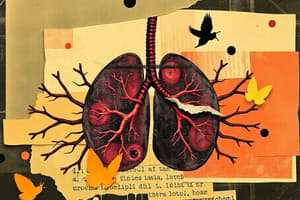Podcast
Questions and Answers
Which of the following correctly matches a stage of aerobic respiration with its location in a eukaryotic cell?
Which of the following correctly matches a stage of aerobic respiration with its location in a eukaryotic cell?
- Glycolysis - Mitochondria (Matrix)
- Glycolysis - Mitochondria (Cristae)
- Krebs Cycle - Cytoplasm
- Electron Transport Chain - Mitochondria (Cristae) (correct)
During the electron transport chain, what is the direct role of oxygen?
During the electron transport chain, what is the direct role of oxygen?
- To combine with electrons and hydrogen ions to form water. (correct)
- To transport NADH from the matrix to the intermembrane space.
- To combine with carbon to form carbon dioxide.
- To produce ATP molecules directly.
How are photosynthesis and cellular respiration related in terms of their reactants and products?
How are photosynthesis and cellular respiration related in terms of their reactants and products?
- They both use the same reactants and produce the same products.
- The products of photosynthesis inhibit cellular respiration.
- They are completely independent processes with no relation to each other.
- The reactants of photosynthesis are the products of cellular respiration. (correct)
In the absence of oxygen, some cells can still produce ATP through fermentation. What is a key difference between lactic acid fermentation and alcoholic fermentation?
In the absence of oxygen, some cells can still produce ATP through fermentation. What is a key difference between lactic acid fermentation and alcoholic fermentation?
Which of the following is an advantage of aerobic respiration compared to anaerobic respiration?
Which of the following is an advantage of aerobic respiration compared to anaerobic respiration?
What are the inputs and outputs of the Krebs Cycle?
What are the inputs and outputs of the Krebs Cycle?
What is the purpose of cellular respiration in eukaryotic organisms?
What is the purpose of cellular respiration in eukaryotic organisms?
Which of these is an example of Lactic Acid fermentation?
Which of these is an example of Lactic Acid fermentation?
Which of the options might directly affect the rate of aerobic respiration in a plant cell?
Which of the options might directly affect the rate of aerobic respiration in a plant cell?
Which of these chemical formulas best describe cellular respiration?
Which of these chemical formulas best describe cellular respiration?
Flashcards
Mitochondria structure
Mitochondria structure
Inner and outer membranes, matrix, DNA, and cristae.
Cellular Respiration Formula
Cellular Respiration Formula
6O2 + C6H12O6 → 6CO2 + 6H2O + 32 ATP
Photosynthesis Relationship
Photosynthesis Relationship
Photosynthesis inputs are cellular respiration outputs.
Aerobic vs. Anaerobic
Aerobic vs. Anaerobic
Signup and view all the flashcards
Why Cellular Respiration?
Why Cellular Respiration?
Signup and view all the flashcards
Aerobic Respiration Sequence
Aerobic Respiration Sequence
Signup and view all the flashcards
Aerobic vs. Anaerobic Advantage
Aerobic vs. Anaerobic Advantage
Signup and view all the flashcards
Glycolysis Location
Glycolysis Location
Signup and view all the flashcards
Fermentation Purpose
Fermentation Purpose
Signup and view all the flashcards
Alcoholic Fermentation Organisms
Alcoholic Fermentation Organisms
Signup and view all the flashcards
Study Notes
- A diagram of the mitochondria should be able to be labeled with the following parts:
- Inner Membrane
- Outer Membrane
- Matrix
- DNA
- Cristae
Cellular Respiration Equation
- Chemical Formula: 6O2 + C6H12O6 —---> 6CO2+ 6H2O +32 ATP
- Word Equation: Oxygen + Glucose —--> Carbon Dioxide + water + ATP
Relationship to Photosynthesis:
- The inputs (reactants) of Photosynthesis are the outputs (products) of cellular respiration.
Aerobic vs. Anaerobic Respiration
- Aerobic respiration requires oxygen.
- Anaerobic respiration doesn’t use oxygen.
- Aerobic respiration produces more ATP than anaerobic respiration.
Organisms and Necessity
- Most eukaryotic organisms perform cellular respiration.
- Cells need to perform cellular respiration to produce energy in the form of ATP.
- ATP is used to do cellular work.
Aerobic Respiration Sequence of Events
- Glycolysis
- Krebs Cycle
- Electron Transport Chain
Aerobic vs. Anaerobic Advantage
- Aerobic respiration makes much more ATP than anaerobic respiration.
Glycolysis
- Location: Cytoplasm
- Inputs: 2 ATP, Glucose, 2NAD
- Outputs: 2 ATP, Pyruvate, 2 NADH
Krebs Cycle
- Location: Mitochondria (Matrix)
- Inputs: Pyruvate, NAD, ADP
- Outputs: 2 ATP, 6 CO2, 8 NADH
Electron Transport Chain
- Location: Mitochondria (Cristae)
- Inputs: NADH, Oxygen
- Outputs: H2O, 32 ATP, NAD
- Function of oxygen: Combines with an electron from the ETC and hydrogen to form water.
Factors Affecting Aerobic Respiration Rate:
- Light intensity
- Color of light
- Temperature
- Carbon dioxide concentration
Anaerobic Respiration - Fermentation
- Purpose: To make ATP when oxygen is not available.
Fermentation Usage:
- Alcoholic fermentation makes alcoholic beverages.
- Lactic Acid fermentation makes yogurt, cheese, and other food products.
- Two types: Lactic Acid vs. Alcoholic
- Inputs: pyruvate
Outputs:
- Alcoholic fermentation produces CO2 and ethanol (alcohol).
- Lactic Acid fermentation produces lactic acid.
Organisms that use Fermentation:
- Alcoholic fermentation is used by yeast.
- Lactic acid fermentation is used by human muscle cells and some bacteria.
Studying That Suits You
Use AI to generate personalized quizzes and flashcards to suit your learning preferences.




